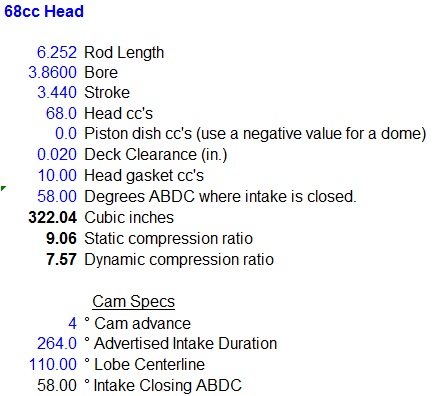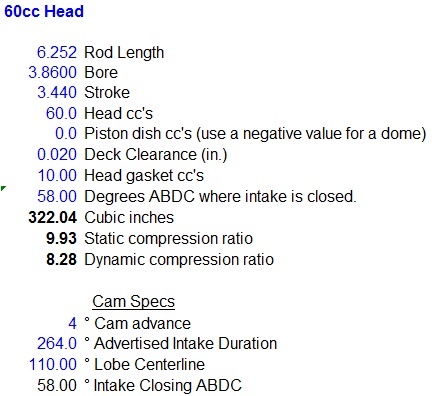|
By Lord Gaga - 7 Years Ago
|
I looked at Eaton's site and read his test of alum. heads. He said his dyno mule's pistons are .025" in the hole and that he used Best gaskets...he doesn't mention quench or detonation in the real world (street).
If the Mummert heads the have 60cc chambers as mentioned in the article, I believe replacing my 68cc G heads and using shim gaskets would give me more compression than I want or need with my 228* @.050" cam. I'm worried about pinging/detonation with thicker gaskets.
There was also an issue with push rod alignment. Two rocker stands had to be milled to correct it.
Is ANYONE running these heads who could offer some information?
|
|
By NoShortcuts - 7 Years Ago
|
Lord Gaga. I would be less concerned about having a detonation problem than I would having problems with head gasket sealing problems. As mentioned in your previous thread, there is a significant difference in the expansion rate of the cast iron engine block and the aluminum cylinder heads you are considering using.
The normal expansion and contraction of these dissimilar metal engine components in engine start-up and cool down will serve to break the seal of the shim steel cylinder head gaskets. Composite cylinder head gaskets will tolerate the difference in the two metal expansion rates. The steel shim cylinder head gaskets will not.
I selected BEST composite gaskets that were designed in concert with John Mummert's input to use with the aluminum cylinder heads John Mummert supplied. Regarding push rod alignment, I vaguely recall Ted Eaton reporting an alignment problem in his initial testing of John's then newly released cylinder heads. I think Ted reported his making a recommended modification in the rocker arm assembly to John Mummert. Consider making a phone call to John or Geoff Mummert to clear-up your understanding of the previously reported problem.
Regarding detonation potential. While quench dimension is a potential issue, keep in mind that aluminum heads will tolerate a higher static compression ratio than cast iron cylinder heads because the aluminum heads dissipate engine heat at a faster rate. In short, aluminum cylinder heads on a y-block can have smaller combustion chambers and not produce the detonation problem the same size combustion chamber would generate with cast iron cylinder heads using the same octane fuel.
|
|
By miker - 7 Years Ago
|
I’m running the aluminum heads. I’m out of town, and don’t have any of my engine records available. But it was a 9:1 motor with a set of 113 ported heads done by Mummert years ago. 040 over, and an offset ground crank, 320cid best I remember. It used an older version of Mummert’s 270 cam. I don’t remember how far down the piston top was, but it wasn’t much.
Putting the aluminum smaller chambers on ran me up to 10.5 or so static. Pre ignition was a problem, but since I’m running EFI with the computer controlling the timing we could set the advance curve as needed. I used the gaskets Mummert sells, with the larger opening on the water passages. Drove and ran fine, I enjoyed the motor.
Then I had a lifter failure. Number 1 exhaust fractured the head (we found 2 pieces in the pan). I think this was a freak failure, no sign of piston valve contact, all other lifters and lobes looked fine. But when we pulled the heads, the piston tops on the intake side had almost no carbon or evidence of combustion. I don’t understand enough about “quench” to reach a conclusion, but my engine builder suggested a ceramic coating to minimize the problem. We put the engine back together with a new cam, a little more duration and wider lobe centers. Ted, John and my builder were all trying to get the dynamic ratio down to a more reasonable ratio. I think we ended up at 8.75 or so. It’s still borderline under heavy load on a hot day, but it runs well.
In retrospect, I should have cut the piston, rebalanced everything, and done it right. But there was a time and space problem that prevented that.
So, if anyone can draw some conclusions and explain a bit more to me, let me know. I don’t know what your compression ratio is, but that’s what I’d be watching.
|
|
By Ted - 7 Years Ago
|
Ditto on the comments on not using the steel shim head gaskets with the aluminum heads. And don’t get too caught up with the quench volumes either.
Rather than relying on the static compression ratio (SCR) to determine might happen in regards to ignition ping (pre-ignition), the dynamic compression ratio (DCR) will give a much more accurate idea of what the engine will tolerate in regards to the octane of the fuel being used. To calculate the DCR, you’ll need all the values needed to calculate the SCR along with two additional two values. Those two extra values are the intake closing event and the connecting rod length. As a general rule, I like to keep the DCR value at a maximum of 8.0:1 which permits the use of 91-93 octane fuel; this allows the total ignition timing to be optimized. At 8.0:1 DCR, there is a safety margin for fuels that don’t meet the advertised 91-93 octane rating. At 8.6:1 DCR, fuel octane and ignition timing do get critical.
Not knowing all the specs on your engine, I took a stab at your combination with both the 68 and 60cc head combinations. What I really had to guess at was the advertised duration on the camshaft (or the actual intake closing ABDC event), the camshaft ‘as ground’ lobe centerline value, and the amount of overbore on your engine. The cam numbers at 0.050” don’t do much good here. The amount of cam advance or retard is also a player here so I arbitrarily put the camshaft installed at 4° advanced. The head gasket volume used here is for the Best Gasket composition head gaskets. Some factors that can be altered on the engine to change the DCR are the valve lash and where the camshaft is installed in relation to the lobe centerline at TDC. Advancing the cam increases the DCR while increasing the valve lash also increases the DCR value. Here are the numbers based on what I put into the calculation.


|
|
By DryLakesRacer - 7 Years Ago
|
|
If needed there is a very good calculator on the Keith Black Piston website for static and dynamic compression ratio. You just fill in boxes, you need to know what is in your engine and camshaft specs. For me the problem is making sure of the cc's in the piston crown or the "eyebrows" cut in your piston.
|
|
By FORD DEARBORN - 7 Years Ago
|
I hope I'm not steering this thread off the path but I have always been unsure of one thing regarding dynamic compression. I used an on line site as mentioned by DryLakesRacer insuring all the correct information is entered, taking in consideration the Y- block head gasket does not have a round bore. Ted's site provides the cc's for various gaskets, thank you for that. Dynamic compression starts the instant the cylinder is sealed, no? So I put a dial on top of the intake valve retainer and at the instant there is no more movement while closing, the degree wheel should then show the point of intake closing with valve lash set correctly. Or, is the cylinder considered sealed a degree or two before the valve goes fully home in the seat? Thanks, JEFF.............................
|
|
By Ted - 7 Years Ago
|
|
FORD DEARBORN (2/6/2018)
I hope I'm not steering this thread off the path but I have always been unsure of one thing regarding dynamic compression. I used an on line site as mentioned by DryLakesRacer insuring all the correct information is entered, taking in consideration the Y- block head gasket does not have a round bore. Ted's site provides the cc's for various gaskets, thank you for that. Dynamic compression starts the instant the cylinder is sealed, no? So I put a dial on top of the intake valve retainer and at the instant there is no more movement while closing, the degree wheel should then show the point of intake closing with valve lash set correctly. Or, is the cylinder considered sealed a degree or two before the valve goes fully home in the seat? Thanks, JEFF.............................
DCR uses the ABDC value where the intake valve just closed or became seated. Solid lifter camshafts typically use 0.020” lobe lift to calculate the advertised duration which makes the advertised duration value handy in calculating the DCR values. If the valve lash is set at 0.019”, then the DCR would be slightly lower simply due to the valve closing slightly later. The most accurate method is of course doing a dial indicator check with the camshaft in the engine but using the advertised duration to find the intake closing event is quick and reasonably accurate without having to actually have the camshaft in the engine. Using that methodology permits a suitable camshaft to be picked out prior to building the engine.
|
|
By FORD DEARBORN - 7 Years Ago
|
The first sentence confirms it. Thanks, JEFF.......................
|
|
By Kahuna - 7 Years Ago
|
Ted
Of the 2 camshaft examples that you provided, what would occur if the Lobe Centerlines were increased to 112 degrees?
Thanks
Jim
|
|
By Lord Gaga - 7 Years Ago
|

Thanks to Ted and everyone who replied.
I'll plug my numbers into the DCR formula and see what pops up with composition gaskets.
Thanks!
|
|